Shirley Valentine
Willy Russell’s play – revived many times and filmed (1989) with Pauline Collins and Tom Conti – is the story of a 42-y-o working class woman from the north of England who breaks out and escapes to recover her true self. It is such a story of hope and possibility that audiences have responded to it since its first performance in 1986.

Here, Natalie Bassingthwaite takes on the role of Shirley and when she first appears on stage, she’s met with cheers, whistles and loud applause. For the opening night audience – and I’m sure subsequently – this is as much an event as it is a play. This is the kind of audience that cheered and applauded Shane Jacobson in The Odd Couple or knew every song in Hairspray. Much as women in the audience might identify with Shirley (and know the ending), they’re there to see Bassingthwaite – described as an ‘icon’ in the publicity - as much as they are there to see a rallying cry, feminist play about woman who wakes up, escapes, discovers sex, and rediscovers her true self.

If you’re unfamiliar with Shirley Valentine, let’s say she’s a lonely woman who spends a great deal of time talking to herself - that is, expressing her thoughts, reflections, feelings and gripes to her kitchen Wall – the things she cannot, dare not tell anyone else. This is Part One of the play – the set-up, the predicament - saved beautifully from mere grumbling, whining and self-pity by being very funny – even about her husband, who, under the jokes, sounds simply awful. Or maybe he’s as repressed as Shirley – something she later understands. Part Two is the day of Shirley’s escape to a fortnight in Greece, thanks to her feminist friend Jane fortuitously offering her a ticket… Shirley hasn’t told her husband and she’s terrified. Part Three is what happens next…
Paul Jackson’s lighting design skilfully heightens Shirley’s emotions and state of mind, especially with the lovely romantic glow in Part Three. A curious (at least to me) decision is the addition of Brady Watkins’ music to Marcello Lo Ricco’s sound design. Maybe there are some sound balance bugs to be ironed out, but from where I was sitting, the rather sudden music stings puzzle, interrupt and don’t enhance. Does the play need music anyway?

Willy Russell’s partisan sympathy for a female protagonist’s unrealised potential is as evident here as in his other hit, Educating Rita – although it’s interesting that in both cases the catalyst for change is a man. That’s perhaps an element in this play’s rather showing its age. Of course, and as we know very well, there are women like Shirley abused and belittled (and worse) everywhere, but here it jars a little to hear Shirley talk as if her life is over at forty-two. Nevertheless, every gag gets a laugh - despite some problems with the north country accent and perhaps making effort a little too visible and lessening the necessary warmth, but the audience is with Bassinthwaite all the way. It’s interesting that in Part Three, Shirley is softly, touchingly happy, no longer griping or afraid - and now she has a story to tell. Here Bassingthwaite comes into her own and we buy the fairytale ending (almost) completely. Any reservations I may have about this production will not deter audiences from coming to and enjoying this production.
Michael Brindley
Photographer: Brett Boardman
Subscribe to our E-Newsletter, buy our latest print edition or find a Performing Arts book at Book Nook.

